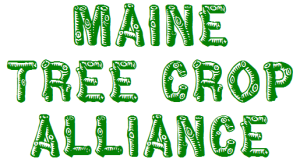Making (re)Discoveries
by Jack Kertesz, 25-April-2014
I went and cut some scion wood from an ancient (?) plum tree in Winslow today. This was at the old Garland Farm, a place I had first visited over 25 years ago. At that time, I stopped to investigate two stately, yard trees with large compound leaves. They were the Yellow Buckeye or Sweet Buckeye, a relative of European Horse Chestnut, that had caught my eye.
In those days, I was more inclined to stop and find out what I could, and I found it easy to converse with people, about what they knew was growing on their property. In a way, it was kind of a “neighborly thing”, like I imagine happened on a more regular basis in the past. You showed up, showed an interest, and were rewarded with the congeniality of the landowner and perhaps some new horticultural find.
On that occasion, I took home a bag of newly-fallen shiny buckeyes, that upon dropping had been freed from their non-spiny husks. I went home and planted a couple of rows of them. The largest of these are now approaching 30 feet and have begun to bear.
This past Fall, I stopped again, to collect more buckeyes to distribute at last October’s Great Maine Apple Day event, with the idea of getting more people interested in planting trees from seed. I gave out some, and prepared a new nursery area on the MOFGA Fairgrounds where I planted even more.
During that visit, I had an extended conversation with the new owner of the property. One of the larger Buckeye trees had now died, but thanks to the squirrels, there were quite a few well established replacements in the yard. The owner was unfamiliar with the origins of these trees and went on to explain what other trees of merit were located here. He mentioned an old plum, by the side of the house. I made a note, probably on a scrap of paper, and left.
For some reason today, that note reappeared on my mental radar as I drove by. I stopped, got permission and collected a few scions. A couple of pictures here may not do justice to the tree. Its wide spreading stature, semi-hollow trunk, and occasional whimsically twisted branches give it lots of character, and make it a truly fine landscape specimen. The photo of the ground, with a cluster of shriveled fruit and dry seed, will give one a glimpse at what the fruit yield must have been like, as a significant portion had been picked and brought in by the owner. Where was that tree 25 years ago?
It had been there then, and I was probably alerted to it then by the former owner. For some reason I failed to make the direct (re)connection. I might have told others about it and assumed they’d check it out and perhaps propagate it. Maybe, that did indeed happen. I will try and find out. What variety is it? I don’t know, it certainly looks like a keeper. It appears to be a European plum, and appearing to be free of black knot, that makes it special, and worthy of attention. Whose attention? It could be yours.
Those of you that may know me realize that I am particularly interested in the promotion, propagation and redistribution of fruit and nut selections with a proven track record. After taking a lengthy break from this activity, I’m back, but I don’t want to do this alone, and you can help. That has always been the intent of the “Network”.
Find out what is growing in your own community or in other places that you may frequent regularly or perhaps just randomly “explore”, then spread around the plant material and information that you collect. Maine has a latent agricultural history that has largely gone untapped.
Thanks to the efforts of John Bunker, and a few others, the search for apple varieties continues to expand and has proven productive. But there’s a whole lot more food and horticultural diversity out there, intact and replicable.
This plum from Winslow, grows on the east side of the Sebasticook River, in an area populated early in Maine’s history, with good soils, a reasonable climate and peppered with diverse tree crops, planted at a time when people’s passion for food growing was driven by need. This dependent culture developed across the state and evidence still remains.
While much has been lost, there is still plenty to recover, uncover, and rediscover. Stop, ask, repeat and when necessary, reconnect. You can make a difference in this preservation effort. I like to remind people that, with the unpredictable and tree injury related weather patterns that Maine experiences, we live in a large proving ground, that “selects” for hardiness and adaptability.
I could leave it at “Go Explore More”. If just a few more people took the time to look around, there would be more to spread around. And those would be a real GEM.
Is what you found a Seedling or Grafted tree ? That’s a question addressed by John Bunker in this essay about discerning the difference when you find an old or young tree.

